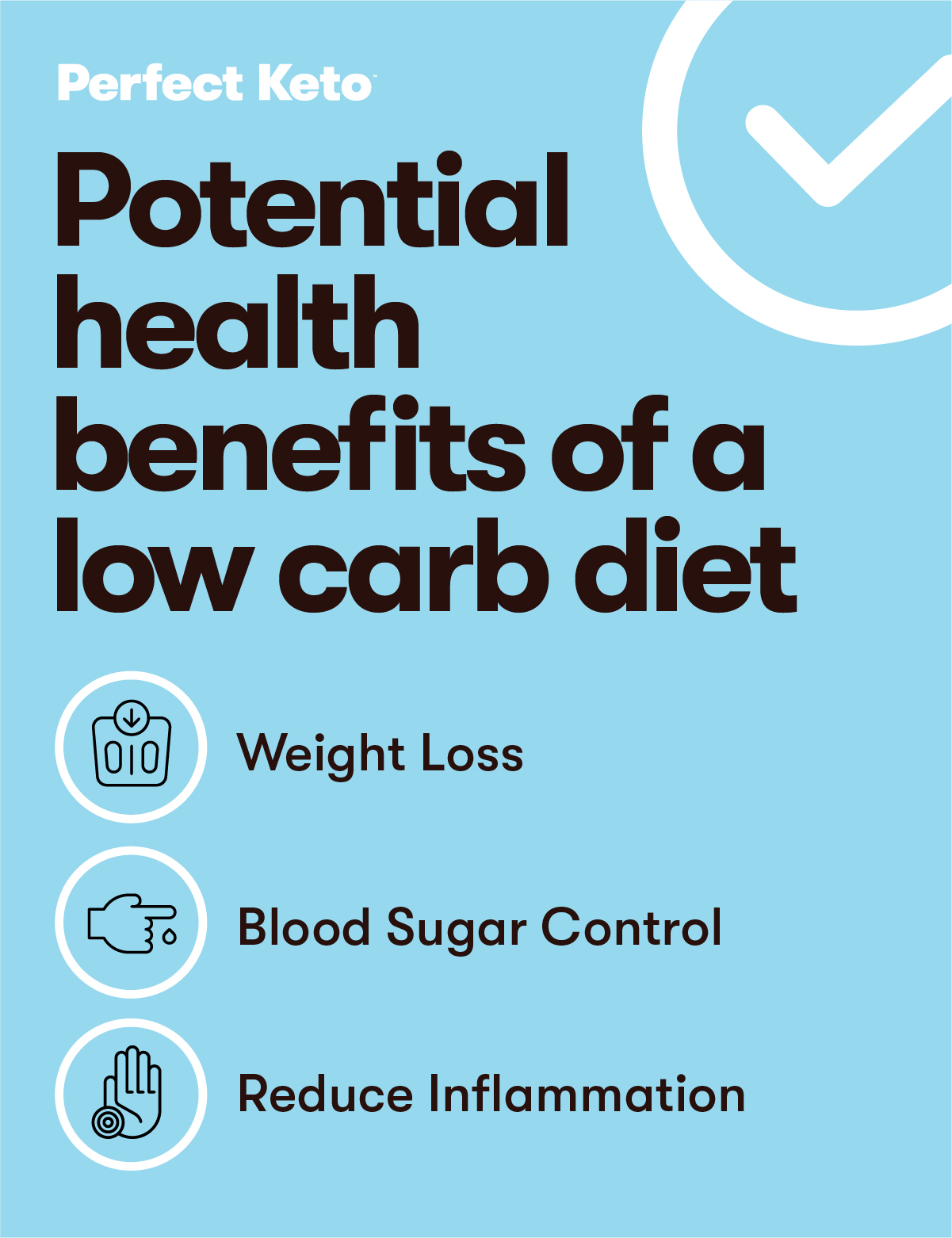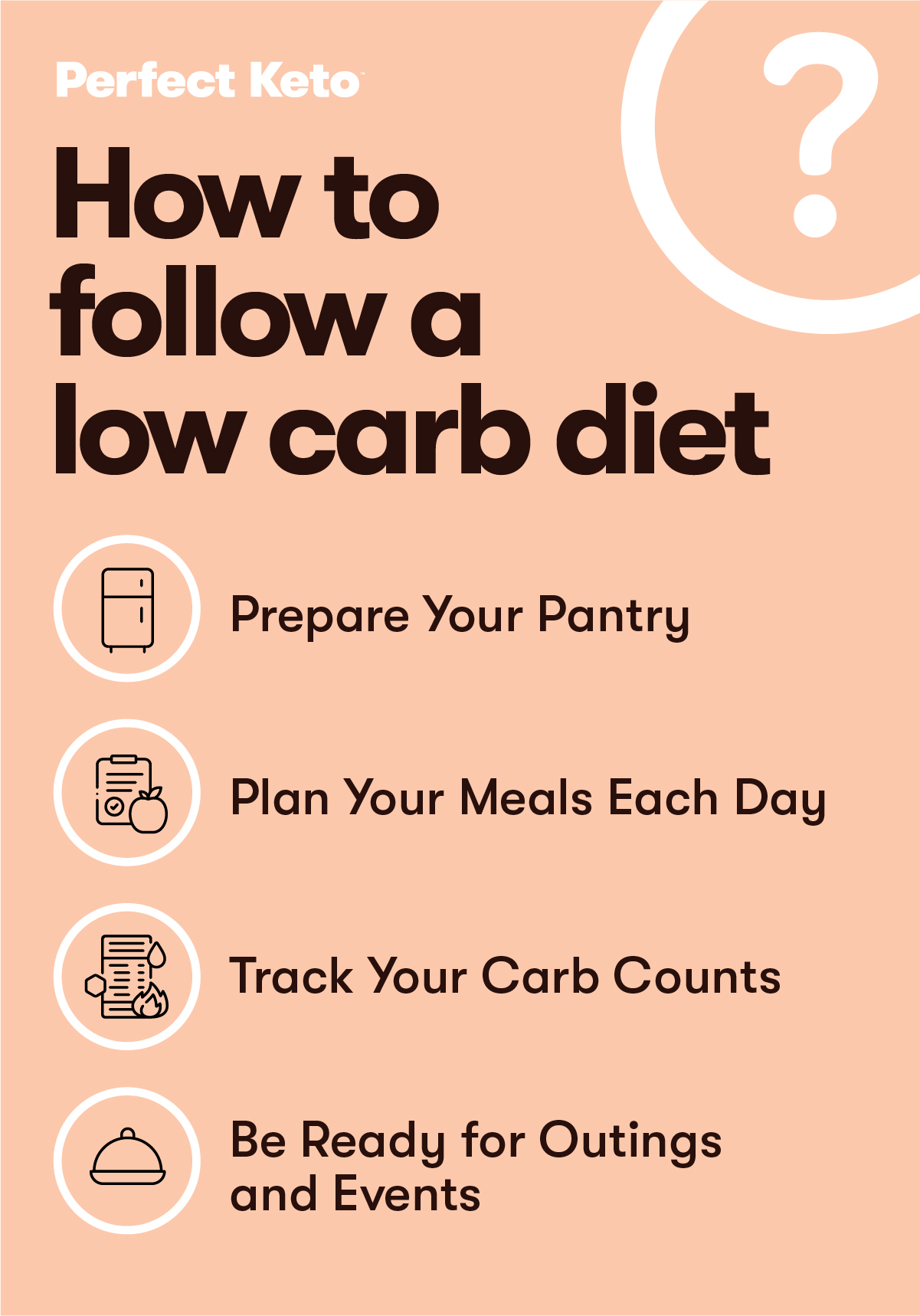
For a long time, our dietary guidelines recommended eating a very high carb diet — including up to 11 servings of high-carbohydrate grain foods per day.
Subscribe to get simple, easy, and insanely delicious new keto recipes every week.
You’re in! We’ll send you delicious recipes once a week 🙂
Most recommendations still say that people should eat up to 65% of their calories in the form of carbohydrates, but many people have realized that they feel much better when they eat fewer carbs.
For that reason, low carb diets have exploded in popularity in recent years. From keto to paleo, people are choosing to eat fewer carbohydrates and making sure that the carbohydrates they do choose are fiber-rich and minimally-processed.
In this guide, you’ll learn what a low carb diet is and how to get started with one.
A low carb diet is any eating style that contains less than 26% of calories from carbohydrates, or about 130 grams of carbohydrates or less per day (*).
However, some people may consider low carb diets to have up to 150 grams of carbs per day (*).
Within the low carb umbrella, there are a number of different diets and programs — some with strict carb limits and some that are much more flexible.
130-150 grams of carbs per day is a fairly generous carb allotment, so eating at this level may allow for some of the benefits of low carb without the rigidity of strict low carb diets (*).
There are numerous reasons why people may follow a low carb diet. Many people choose low carb eating patterns to lose weight, manage their blood sugar levels, or improve their metabolic health.
Additionally, some people may naturally fall into a low carb diet when they choose to cut out certain processed foods, like added sugars or refined grains.
Low carb diets have been shown to improve:
There are several different types of low carb diet. Some of the most common include:
There are also several other eating patterns and commercial diets that can be considered low carb.
The potential health benefits of low carb diets include weight loss, better blood sugar control, and reduced inflammation.

One of the major benefits of low carb diets is weight loss.
We know, however, that weight loss isn’t the solution to all health problems, and people can be healthy at a range of weights. Regardless, a low carb diet can be a helpful tool if weight loss is a goal for you, or something that your doctor has recommended.
Since they’re low in carbs, low carb diets are typically higher in protein and fat — which are more filling. This makes it easier to stick to a calorie deficit (*).
Additionally, low carb diets may help to improve insulin resistance, which can regulate the appetite (*).
Many people have reported massive success with weight loss using a low carb diet, and there are several research studies showing that low carb diets are helpful for weight loss too (*).
Additionally, low carb diets may help to improve blood sugar control — especially in people with diabetes (*).
Of all the macronutrients (carbs, fat, and protein), carbs raise blood sugar levels the most.
Over time, this can lead to insulin resistance. Insulin is a key blood-sugar regulating hormone, and over time insulin resistance may lead to weight gain and type 2 diabetes.
Many people with type 2 diabetes have found that a low-carb diet can help improve their insulin sensitivity and their blood sugar levels.
In addition to weight and blood sugar levels, low carb diets may be helpful for inflammatory conditions (*).
Inflammation can drastically affect overall health, and may be linked to heart disease, digestive problems, infertility, cognitive decline, and many other health concerns (* , *).
Research shows that low carb diets may help reduce inflammation, so they could be useful for these and many other conditions (*).
Low carb diets can vary pretty drastically in carbohydrates, from a zero-carb carnivore diet to a more generalized low carb diet that could contain 100 grams or more.
For the purposes of this article, we’ll share foods that are appropriate for a more flexible low carb diet. However, we have plenty of resources available for stricter low carb diets, like keto and carnivore. Be sure to check out our keto shopping list and carnivore shopping list.
Here are the foods that you can eat on a flexible low carb diet:
Just remember that many of the foods on this list do contain moderate or high amounts of carbs, and therefore should be eaten in moderation in order to fit a low carb diet.
Subscribe to get simple, easy, and insanely delicious new keto recipes every week.
You’re in! We’ll send you delicious recipes once a week 🙂
On the other hand, here are the foods that should be avoided on a low carb diet:
Just remember that stricter low carb diets, like keto and carnivore, will have more comprehensive lists of foods to avoid that may include several foods that are otherwise allowed on low carb diets.
This three-day low carb meal plan is a great way to get started on a low carb diet, or you can use it for inspiration as you create your own low carb meal plans:
Low carb meal planning can be really easy as long as you have a well-stocked freezer and pantry. Keeping a variety of meats, vegetables, and fats on hand can make meal planning and cooking really straightforward.
You can plan breakfasts, lunches, and dinners by simply choosing a protein, fat, and vegetable for each meal. You can do this based on what’s on sale each week, what’s in your kitchen, or a combination of the two. For example, salmon, butter, and asparagus, or chicken, avocado, and salad greens.
If you have a higher carb limit, you can also add a small serving of carbs, like rice, potato, or fruit to each meal to make it fit your macros better.
The result is well-balanced, low carb meals with minimal time spent meal planning each week.
Low carb diets are mostly safe, but there may be some risks associated with them.
Researchers have found that low carb diets, because they are high in fat, may increase cholesterol levels. This is especially true for keto (*).
Additionally, you should speak to your healthcare provider before starting a low carb diet if you have any pre-existing medical conditions, or if you’re taking any prescription medications.
Low carb diets may affect your blood sugar and blood pressure levels rapidly after starting them, so if you’re taking medications for these things your doctor needs to be aware so that they’re able to make adjustments if needed.
Here are a few tips to help you follow a low carb diet successfully.

First, it’s a good idea to stock you pantry, fridge, and freezer with low carb foods. This will ensure that you have plenty of low carb options for meals and snacks at home, and make it easier to stick to your diet.
Additionally, it’s a good idea to get rid of high carb foods if you’re able to. With them completely out of the house, they’ll be much less tempting.
If you share a home with people who don’t eat low carb, see if they’d be willing to move their high-carb foods somewhere where you can’t see them, like a closet or another room outside of the kitchen and pantry area.
Next, it’s important to plan your meals each day. You don’t have to do this too far in advance, but even just thinking about what you’re going to eat at each meal when you wake up in the morning can be very helpful. You need to have a plan to help avoid slip-ups.
If you prefer to plan ahead, you can choose one day per week to be your meal planning and meal prep day. Many people choose Sunday. You can spend the day planning each meal for the week, and then doing as much advance prep as you can — like assembling breakfasts and lunches, pulling meats from the freezer to thaw, or chopping vegetables.
It can be deceptively easy to overeat carbs, so tracking will be an important part of starting your low carb diet. You may not always have to track, but it’s a good idea to do so until you become familiar with the correct portion sizes and carb counts of your regularly-eaten foods.
To be sure that you’re tracking accurately, it’s also a good idea to invest in a food scale. Studies have shown that we are notoriously bad at estimating portion sizes, and that we tend to underestimate how much we eat.
Some of the most difficult situations to navigate on low carb include going to parties or restaurants. It’s a good idea to always plan in advance what you’re going to eat in these situations, so that you don’t get off track.
If there’s not going to be any low carb food available at the event you’re attending, you can bring snacks like beef jerky with you, or eat before you arrive.
It depends. If you’re on keto, you should limit your carb intake to roughly 25-50 grams per day. Other eating patterns may have more flexible carb limits. Still, calorie intake is important for weight loss, so no matter your carb intake you need to make sure you’re eating at a caloric deficit.
The three main types of low carb diet include strict, moderate, and liberal. Strict low carb diets include those with very low carb counts such as keto or carnivore. Moderate low carb diets may allow for up to 100 grams of carbs daily, while liberal low carb diets offer the least restriction and may allow for anywhere from 100-150 grams of carbs daily.
Yes, 100 grams of carbs per day is a low carb diet, although it’s not keto and you probably won’t enter ketosis at that level of carb intake.
The most important consideration for losing belly fat is calorie restriction. Unfortunately, you can’t target fat loss in a certain part of your body. Still, it’s a good idea to avoid carbs that have been associated with obesity, like refined grains and added sugars.
Low carb diets include any diets or eating plans that contain roughly 130-150 grams of carbs, or less. This amount of carbs is significantly lower than most public health recommendations, but many people have found that eating fewer carbs helps them feel much better.
The benefits of low carb diets include weight loss, improved blood sugar control, reduce inflammation, and a myriad of other health improvements for specific conditions like PCOS and cognitive decline.
However, remember that you need to be careful with portion sizes for the carbs you do include in your diet so that you don’t exceed your carb goal.
Subscribe to get simple, easy, and insanely delicious new keto recipes every week.
You’re in! We’ll send you delicious recipes once a week 🙂
Even if a strict low carb diet isn’t right for you, most people may benefit from reducing their carb intake by removing high-carb foods like sodas, sugary treats, and highly-refined grains from their diet.